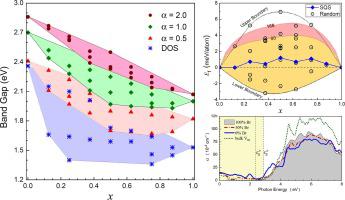当前位置:
X-MOL 学术
›
Comp. Mater. Sci.
›
论文详情
Our official English website, www.x-mol.net, welcomes your
feedback! (Note: you will need to create a separate account there.)
Physical spread and technical upshift in the band gaps of visible-light photocatalytic bismuth oxyhalide solid solutions
Computational Materials Science ( IF 3.1 ) Pub Date : 2020-11-01 , DOI: 10.1016/j.commatsci.2020.109870 Xuejian Huo , Liang-Feng Huang
Computational Materials Science ( IF 3.1 ) Pub Date : 2020-11-01 , DOI: 10.1016/j.commatsci.2020.109870 Xuejian Huo , Liang-Feng Huang

|
Abstract Semiconductor band gap determines the wavelength range of the utilized light, and is a key factor for many optical applications, e.g., photocatalysis and optoelectronic devices. As a superior group of bismuth oxyhalide, binary BiOI x Br 1 - x solid solutions have the visible-light band gap ( e g = 2.8 ∼ 1.8 eV) that is readily tunable by changing the halogen composition. However, there remains a long-standing problem that the e g s of BiOI x Br 1 - x have never been exactly confirmed by experimental measurements (with an error ≲ 0.5 eV). Using density-functional-theory calculations, we find that all of the sampled random structures for BiOI x Br 1 - x solid solutions have readily accessible stabilities, and the random arrangement of halogen atoms can result in a large physical spread ( ∼ 0.8 eV) in electronic e g . Such large band-gap variation with halogen-atom arrangement is attributed to the sensitive dependence of valence-band-maximum level on the local halogen composition. In the optical absorption spectra, we find the remarkable upshift of the optical e g by 0.5 eV when only a small absorption-edge threshold (e.g., 2 × 10 4 cm - 1 ) is used, which is ascribed to the small amount of conduction-band-minimum states. To further reveal the finite optical absorption within band gap that is responsible for the absorption-edge threshold existing in experimental characterizations, we finally calculate the optical absorption spectra of surfaces and find it is the metallic surfaces induced by halogen deficiency that causes the finite in-gap absorption. Such mechanism derived from the two-dimensional defects (i.e., surfaces) guides us to find similar phenomena on a zero-dimensional defect (i.e., halogen vacancy). The band-gap upshift, together with the physical spread, can explain the band-gap uncertainty existing in experimental results.
中文翻译:

可见光光催化卤氧化铋固溶体带隙的物理扩散和技术上移
摘要 半导体带隙决定了所用光的波长范围,是许多光学应用(例如光催化和光电器件)的关键因素。作为一组优良的卤氧化铋,二元 BiOI x Br 1 - x 固溶体具有可见光带隙(例如 = 2.8 ∼ 1.8 eV),可通过改变卤素组成轻松调节。然而,仍然存在一个长期存在的问题,即 BiOI x Br 1 - x 的 egs 从未被实验测量准确证实(误差 ≲ 0.5 eV)。使用密度泛函理论计算,我们发现 BiOI x Br 1 - x 固溶体的所有采样随机结构都具有易于获得的稳定性,并且卤素原子的随机排列会导致较大的物理扩散(~ 0.8 eV)在电子例如。卤素原子排列的这种大带隙变化归因于价带最大值水平对局部卤素成分的敏感依赖性。在光吸收光谱中,我们发现当仅使用一个小的吸收边缘阈值(例如,2 × 10 4 cm - 1 )时,光学的显着上移例如 0.5 eV,这归因于少量的传导 -带最小状态。为了进一步揭示导致实验表征中存在的吸收边缘阈值的带隙内的有限光吸收,我们最终计算了表面的光吸收光谱,发现是由卤素缺乏引起的金属表面导致了有限的输入。间隙吸收。这种机制源自二维缺陷(即,表面)指导我们在零维缺陷(即卤素空位)上找到类似的现象。带隙上移与物理扩展一起可以解释实验结果中存在的带隙不确定性。
更新日期:2020-11-01
中文翻译:

可见光光催化卤氧化铋固溶体带隙的物理扩散和技术上移
摘要 半导体带隙决定了所用光的波长范围,是许多光学应用(例如光催化和光电器件)的关键因素。作为一组优良的卤氧化铋,二元 BiOI x Br 1 - x 固溶体具有可见光带隙(例如 = 2.8 ∼ 1.8 eV),可通过改变卤素组成轻松调节。然而,仍然存在一个长期存在的问题,即 BiOI x Br 1 - x 的 egs 从未被实验测量准确证实(误差 ≲ 0.5 eV)。使用密度泛函理论计算,我们发现 BiOI x Br 1 - x 固溶体的所有采样随机结构都具有易于获得的稳定性,并且卤素原子的随机排列会导致较大的物理扩散(~ 0.8 eV)在电子例如。卤素原子排列的这种大带隙变化归因于价带最大值水平对局部卤素成分的敏感依赖性。在光吸收光谱中,我们发现当仅使用一个小的吸收边缘阈值(例如,2 × 10 4 cm - 1 )时,光学的显着上移例如 0.5 eV,这归因于少量的传导 -带最小状态。为了进一步揭示导致实验表征中存在的吸收边缘阈值的带隙内的有限光吸收,我们最终计算了表面的光吸收光谱,发现是由卤素缺乏引起的金属表面导致了有限的输入。间隙吸收。这种机制源自二维缺陷(即,表面)指导我们在零维缺陷(即卤素空位)上找到类似的现象。带隙上移与物理扩展一起可以解释实验结果中存在的带隙不确定性。











































 京公网安备 11010802027423号
京公网安备 11010802027423号